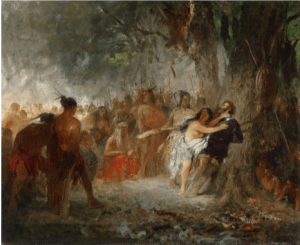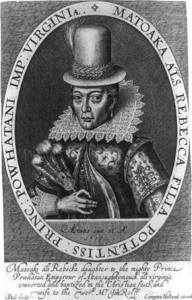By Gemma McLean-Carr
Second-Year History Student
 Johann Friedrich Engel Pocahontas, c.1921.
Johann Friedrich Engel Pocahontas, c.1921.
The life of Pocahontas (born Matoaka) has been frequently replicated and represented in literature, art and films since the beginning of the nineteenth century; her story is most widely known through the Walt Disney animated film (1995). This may be seen by some to be of little of importance, there is no claim to the truth within these representations and the animated film is fictional in nature. However, the influence of these misrepresentations are significant when looking at the past especially when framed within the context of colonisation (an aspect of the past which remains largely unseen within wider historical curricula and misunderstood by the majority). These representations need to be questioned, in particular the Walt Disney film due is its popularity, in order to help academics to unravel constructions of the past and explore the misleading and inaccurate nature of these sources.
The animated retelling of Pocahontas presents a merging culture as a result of English colonisation in the early seventeenth century; exploring the romantic connection between protagonist Pocahontas and Englishman John Smith. Although the film offers a strong, ethnic-minority female lead and attempts to introduce themes of eco-consciousness into its narrative, it has been widely criticised for the portrayal of both Pocahontas and the Native American population.
 ‘Pocahontas’ (1906) Painting by Elmer Boyd Smith
‘Pocahontas’ (1906) Painting by Elmer Boyd Smith
A key criticism of the Pocahontas film aligns itself with the stripping of the Native American cultural context in order to mould the protagonist into a character that suits the values and perspectives of mainstream media – therefore manipulating the past until it no longer represents its origins. When applied to the animated film, this results in the experiences of Native communities in America being no longer prioritised and instead hidden behind a media agenda.
Many critics of the film argue that rather than an attempt to raise awareness and understanding of the culture and history of the Native American population, the film achieves the opposite by retelling a story removed from the historical truth – in turn presenting a euro-centralised and whitewashed version of the past. Critics stress that the animation enforces the contemporary stereotype of Native Americans as ‘noble savage’, presenting the misconception of the North American Native American communities as inferior or no longer active in contemporary society. Concern is also raised at the glorification of native American religious beliefs; this is especially relevant when considered alongside contemporary exploitation of these beliefs for economic benefit.
 ‘Pocahontas and John Rolfe’ (c.1850) Portrait by J.W. Glass
‘Pocahontas and John Rolfe’ (c.1850) Portrait by J.W. Glass
Within the film, the characterisation of Pocahontas is considered to be westernised in nature; her rejection of marriage to the Native American Kokoum reflects westernised beliefs of individual destiny – accompanied by her instant attraction of the Englishmen John Smith. Conflicts are also presented between the ‘fate’ of Pocahontas to lead her people and the opportunity to experience the wealth and advancements of western civilisation.
Implications also arise when looking at the concluding elements of the film whereby the suffering of colonised people at the hands of White settlers is conveniently overlooked and avoided. In truth, Pocahontas was held as ransom as English settlers demanding payment of corn and the return of goods. Violence and conflict between Native Americans and the English led to Pocahontas expressing her wish to marry John Rolfe. The marriage, viewed as a peace-making event and commonly known as the ‘’Peace of Pocahontas’’ was followed by Pocahontas converting to Christianity, being renamed Rebecca and eventually moving to England where she was considered an Indian princess.
 ‘Portrait of Pocahontas’ (1616) Portrait by Simon van de Passe
‘Portrait of Pocahontas’ (1616) Portrait by Simon van de Passe
It is important to note that as an animated film, Disney never claims to present an accurate image of Pocahontas and her life but attempts are made to interweave parts of the historical narrative into the animation. However, awareness of the historical narrative seems, to me, to be a valuable asset in understanding the forced position of Native Americans during English colonisation and their treatment by English colonisers. Representations of these events by Disney still present the underlying issues of these ventures through an entertaining perspective. Both perspectives are of importance when considering the wider implications of this –as a form of entertainment but also through the possibility of educating oneself to the mistreatment and exploitation of native communities from this period to the present.
Bibliography:
Amy Aidman and Debbie Reese, ‘Pocahontas: Problematizing the Pro-Social’ Paper presented at the Annual Meeting of the International Communications Association, delivered May 1996.
Karenne Wood, ‘Prisoners of History: Pocahontas, Mary Jemison, and the Poetics of an American Myth’ Studies in American Indian Literatures (2016), 73-82.
Walt Disney Company, Pocahontas (1995). Directed by Mike Gabriel and Eric Goldberg, Produced by Jim Pentecost.
Debra Michals, ‘Pocahontas’ National Women’s History Museum https://www.womenshistory.org/education-resources/biographies/pocahontas accessed 21 November 2020
Images used:
Johann Friedrich Engel Pocahontas, c.1921. Painting: Johann Friedrich Engel via Wikimedia Commons (https://commons.wikimedia.org/wiki/File:Johann_Friedrich_Engel_Pocahontas.jpg), accessed 21 November 2020
Pocahontas, 1906. Painting: Elmer Boyd Smith via Wikimedia Commons (https://commons.wikimedia.org/wiki/File:Pocahontas-13.jpg), accessed 21 November 2020.
Pocahontas and John Rolfe portrait, c.1850. Portrait: J. W. Glass via Wikimedia Commons (https://commons.wikimedia.org/wiki/File:Pocahontas_Rolfe_crop.jpg), accessed 21 November 2020.
Portrait of Pocahontas, 1616. Portrait: Simon van de Passe via Wikimedia Commons (https://commons.wikimedia.org/wiki/File:Pocahontas_by_Simon_van_de_Passe.jpg), accessed 21 November 2020